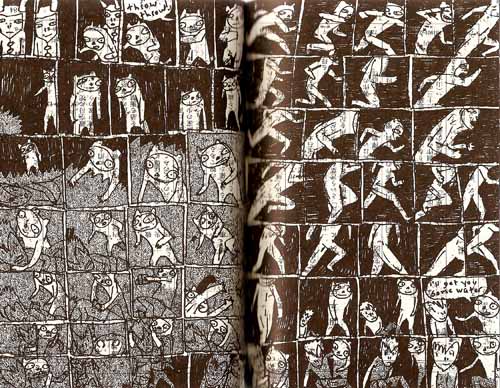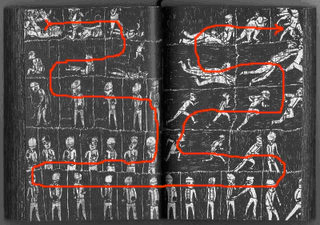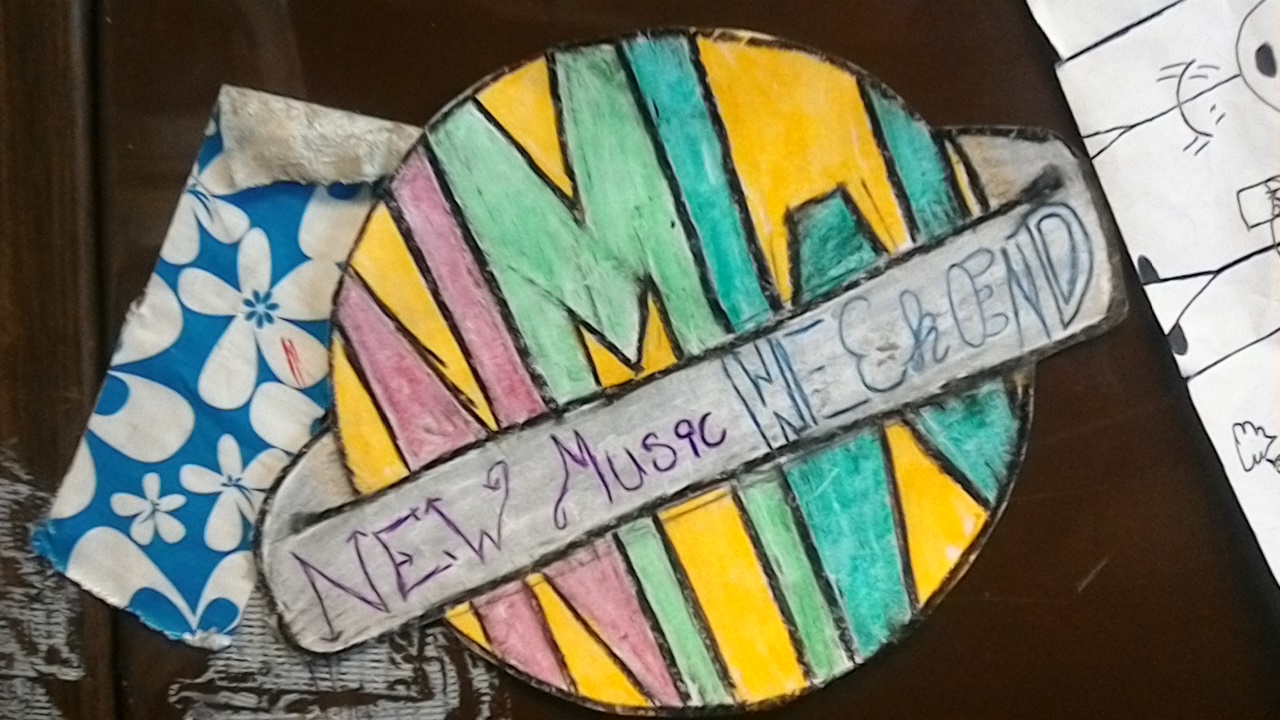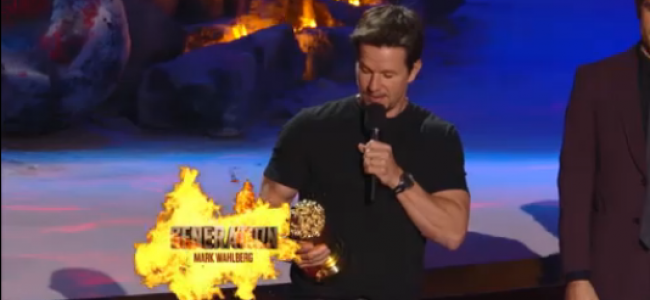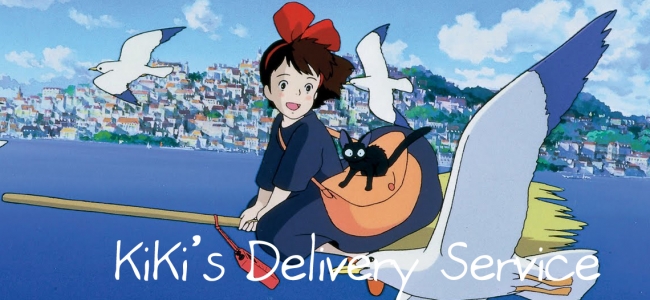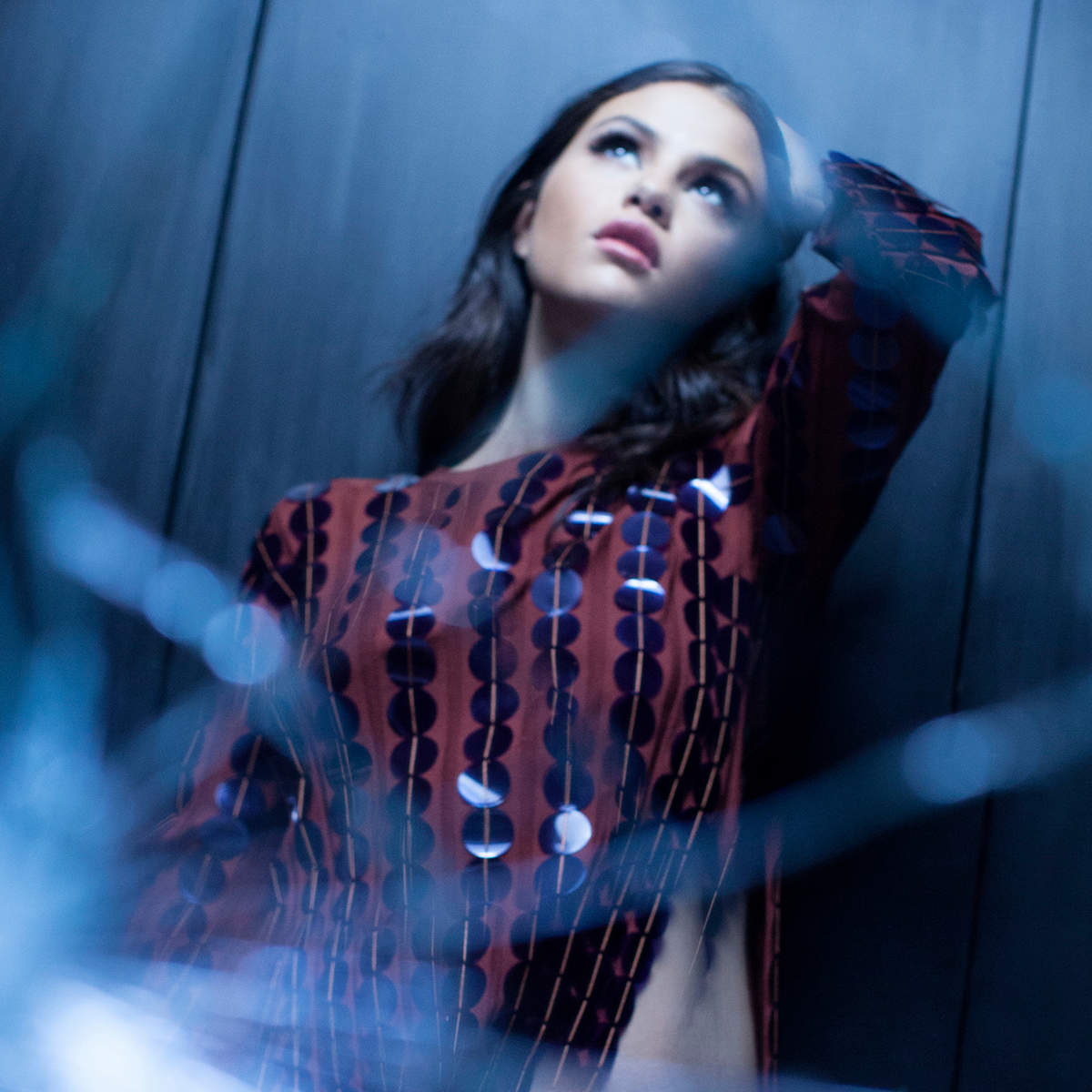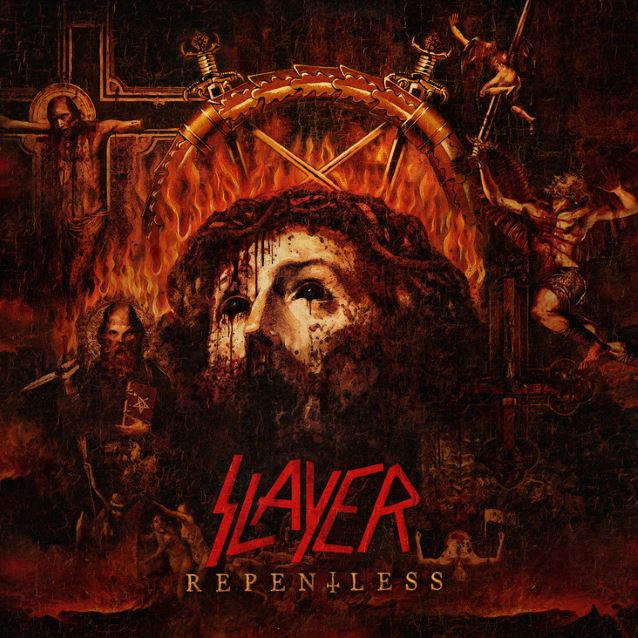Community Post: This article was submitted by a member of our community. Find out how you can publish your own writing here!
Title: Maggots
Author: Brian Chippendale
Paperback: 352 pages
Publisher: PictureBox (November 1, 2007)
Language: English
ISBN-10: 0978972260
ISBN-13: 978-0978972264
Product Dimensions: 5.9 x 4 x 0.8 inches
Shipping Weight: 7.2 ounces (View shipping rates and policies)
Average Customer Review: 4.2 out of 5 stars (on Amazon)
Amazon Best Sellers Rank: #767,056 in Books (on Amazon)
Characters:
???
Hot Potato
Rabbit
Maggots features a phantasmal cast of non-repeating thousands, rising and falling like a fever dream. The story mainly follows Hot Potato, which seems to be Chippendale’s comic book alter-ego, and his ex/current long-distance girlfriend, Rabbit.
Setting:
???
Maggots seems to take place in some floating limbo nether region of subterranean tunnels and secret passageways. Maggots might be said to take place in some spectral, bizarro version of Chippendale’s home, Providence, Rhode Island, or else occurring solely in its creator’s subconscious.
Brian Chippendale may be best known as the hyper-manic singing drummer from Providence, RI’s Lightning Bolt, but for those in the know, he is also a comic book artist, illustrator, and graphic designer, of equal renown.
With Lightning Bolt’s newest opus, Fantasy Empire, being released today on Thrill Jockey records, we thought we’d take the opportunity to look at one of Chippendale’s whacked out graphic novels, Maggots.
Origin Story
Maggots’ dense, pen-drawn 350 pages were originally drawn in 1996 – 1997, a scant two years after Lightning Bolt’s formation. Maggots was drawn on a leftover Japanese book catalog, causing Chippendale to cover every page in thick, scratchy black ink, with the original Japanese characters peeking through the negative space. The book itself would not see the light of day until 2007, however, when it found a home at Picturebox.
Maggots is the visual equivalent of a dubbed-over thrift store tape, with ghost echoes of the original audio sneaking through the static.
 The Quest
The Quest
I have been a massive, massive Lightning Bolt fan for years and years, but just recently discovered that Chippendale wrote comic books as well, although I knew he was responsible for LB’s album covers. While doing research on Fantasy Empire, which I was writing about for another publication, I came across Maggots. I first went looking for a digital copy, for ease and speed, as I wanted to get something up for the record release day, but no dice. Copies were available online, at a reasonable price, but wouldn’t reach me in time.
Luckily, I was able to locate the last remaining reasonably-priced copy in all of Portland at Powell’s, so for the sake of art and noise rock, I grabbed my headphones and made for downtown.
While riding the 35 bus, I realized that I had far fewer cassette tapes on my person then I had predicted, and would be out of music before the bus ride was even over. I had a few dollars, so I vowed to go sniff out some cheap tapes at 2nd Avenue Records. I managed to find cheap copies of tapes by Blind Idiot God, a crunchy speed metal band on a dubbed out acid trip, and some cheap jazz tapes.
Smiling like an idiot, I made my way to the City Of Books. It was a rare sunny day in Portland, so Powell’s was crawling like an ant hive. Weird noise and scathing metal guitars rushed over me, as I wend my way through grannies and home bums, to the x-cult section of the bookstore. Chippendale’s work is so weird, it doesn’t even up with the graphic novels.
I mention all of this because, as we all know, comic books and graphic novels are more than an artifact. They are an event; a lifestyle; a way of looking at the world. That feeling, when you get a new TPB and open the poly-bag; the days and hours you spend, on buses and park benches; in lonely cafeterias; staring out of your bedroom window.
Comic books, similar to the underground music scene, can be both connecting and disassociated, at the same time. We connect with the wider culture, as a whole, and find occasional kindred spirits, either locally or virtually, but we also spend A LOT time alone, with mass society and culture not giving a duck about our passions.
As I made my way through that crowded bookstore, listening to dyslexic dub reggae at unhealthy volumes, I experienced a sliver of what Chippendale must’ve felt like, living at the art space Fort Thunder, in Providence, and the early van days of touring with Lightning Bolt.
Cool story, bro. What’s the comic about?
You know, that is a very good question, and not an easy one to answer. Maggots is best seen as an experimental, surreal, psychedelic autobiographical distortion. The action follows around Hot Potato, who gets the news that his ex/current long-distance girlfriend, Rabbit, is coming to visit.
Hot Potato asks himself existential questions, familiar to all artists, “Do I even have time for human connection?”, amidst fleeing for his life from nameless, faceless horrors down blind tunnels. It comes off like a black metal version of Adventure Time.
Maggots is more of a connected series of bizarre vignettes, following their own dream logic, that suck you in like a 3 day fever dream, and never lets you go.
Experimental? Existential? Sounds heavy.
Definitely. The most notable thing about Maggots is that it does not follow the traditional, Western left-to-right reading pattern, instead following a snaking zig-zagging, left to right, right to left pattern, from the top down, on the left page, and then running back up the right side.
Except for when it doesn’t. “Stay alert,” as Chippendale advises.
Sounds disorienting, right?
It definitely is. The unconventional narrative structure keeps you on your toes, constantly questioning what is happening, “Am I in the right place? Does this make sense?” This is not a passive, easy reading experience. It is a full-blown immersive experience, catapulting you into the frontal lobe of a struggling musician, as they try and make it.
So is it worth it?
Most assuredly. First of all, one of art’s greatest abilities is the potential for empathy, for relating to someone who is not you, with different experiences, a completely different background. As art lovers, we live many, many lives and are many, many different people. This breaks down our own identities, our own rigid ways of thinking, creating possibility and potential, rather than a blindfolded, reality tunnel existence.
Secondly, Maggots is disturbing. Not in any blood and gore and meathooks kind of way, but in a get under your skin like a Peruvian fly infestation sense. And then burrows. It’s start, and effecting, while dealing with banal subject matters such as beer and rent.
Lastly, Chippendale deserves stadium’s worth of applause for actually using the medium for all it’s worth, instead of the typical picture book with words structure. It reminds me of William S. Burrough’s quote about literature being fifty years behind film and painting, causing he and Brion Gysin to develop the cut-ups method.
What does this have to do with music?
If you’re familiar with Lightning Bolt’s music at all, you may see traces of their distinctive cover art, which Chippendale is also responsible for, which comes across like a Jackson Pollock mating with a Pikachu. There’s a similar textural element, and obviously, a fondness for black-and-white.
But digging beneath the surface, we begin to sense Chippendale’s fascination with irregular patterns and sequences. He is no Ringo backbeat drummer – more like Rashied Ali with cybernetic Vishnu arms. He’s all over the place, a whirlwind of motion, and it is, quite frankly, kind of astonishing that you can get even a sense of that, in his panels.
Just as importantly, however, is Chippendale’s lack of compromise. Lightning Bolt may be seen as one of the underground’s purest exports, that have built a solid following, but don’t even play on the stage, instead, whipping out the frenzy from the chaos of the mosh pit.
These guys are DOWN, the real deal. This is the underground, pure and undiluted, from paint-sniffing basement dwellers, and pale, nocturnal misanthropes.
Final Thoughts
If you’re a fan of Lightning Bolt, Brian Chippendale, experimental comics, good art, or underground culture, you need this now!!! Also worth noting, this is Chippendale’s only graphic novel that is available at a reasonable price, with his other two, Ninja and If ‘N Oof fetching upwards of $300, if you can find them. Here’s your chance to discover his work!
As one final addendum, make sure to keep your eyes peeled for Puke Force, which will be released as a hardcover in the fall from Drawn & Quarterly.
Lightning Bolt’s Fantasy Empire is out today on Thrill Jockey.
Read more about it at our Music Monday feature.
Musical Lines will be an on-going investigation into the cross-pollination between music and comics. Got a comic drawn by a musician, based on a musician, or music about comic books, that you’d like to see here? Let us know in the comments!
Brian Chippendale – Maggots
@CHIRPENDALE
Blackpusone.blogspot.com
Lightning Bolt FB
@thrilljockey
Thrill Jockey FB
Community Post: This article was submitted by a member of our community. The views expressed are the opinions of the designated author, and do not reflect the opinions of the Overmental as a whole or any other individual. We will gladly cooperate in the removal of plagiarism or any copyright infringement. Please contact us here.
